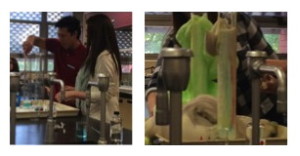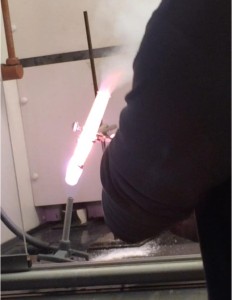SCC Chemistry Club Events in October and November 2015
On November 13, 2015, the Sacramento City Chemistry Club hosted a Chemistry Club Social to welcome members of the Chemistry Club at Cosumnes River College to Sacramento City College. The event was held in one of the lecture rooms of Lillard Hall. Members from both Chemistry clubs were able to meet each other and get to know one other. Food and drinks were provided by the SCC Chemistry club. The social hour was a success and everyone from both clubs enjoyed themselves.
After the social hour was over, the real fun began as the SCC Chemistry club led everyone to one of lab rooms for the reaction demonstrations given by Ryan, the SCC Chem Club’s Experiment Coordinator. The SCC Chem club had four demonstrations planned for this event: elephant toothpaste, burning dollars, exploding gummy bears and reactions of sulfuric acid with pure granulated sugar and p-nitro aniline.
The first demonstration was the elephant toothpaste demonstration. This demo was designed to be interactive and allowed for members from the CRC Chem club to volunteer and take part in this experiment. Hilary, the CRC Chem Club President and a member from the CRC Chem club volunteered to take part of this demo and added food coloring to the potassium iodide and dish detergent solution to change the color of the paste after it reacts with hydrogen peroxide. The demo went very well and the elephant toothpaste turned out be very colorful.
The second demonstration was the Burning Money demo. For this demo, a dollar bill was soaked in isopropyl ethanol for a few minutes. From there, it was picked up by tongs or forceps and was then lit on fire. In this reaction, the fire only burns away the isopropyl alcohol that soaking the surface of the dollar bill, leaving the dollar bill left unscathed but still damp.
The next demonstration was the exploding gummy bear demonstration. For this demonstration, pure cane sugar was used instead of gummy bears. This reactions calls for to melt the potassium chloride inside of a test tube to a liquid. After the potassium chloride has been liquefied, the cane sugar was added to the potassium chloride solution. The reaction yielded a very luminous lavender glow, demonstrating the energy release from the reaction.
The grand finale of the demonstrations was the Carbon snake reactions. There were two demos set up. One set up demonstrated the reaction of regular cane sugar with concentrated cane sugar and the other set up showed the reaction of p-nitro aniline with concentrated sulfuric acid. This reaction is best known for producing pyrostat, which is a fire quenching substance and as a decomposition reaction that forms a solid brown-black foam as its product. For this reaction, a small crucible was filled with either sugar or p-nitro aniline and about half a milliliter to a milliliter of concentrated sulfuric acid was added to the crucible. The crucible was then placed in a fume hood on a wire gauze over a Bunsen burner and was allowed to heat up. From there, it was only a matter of time until the brown-black column sponge or formation shaped like a snake spontaneously appears. The product spontaneously appears when a rapid production of gases, carbon dioxide, nitrogrn, water vapor, and possibly some sulfur dioxide, causes the melted p-nitro aniline to expand and develop into a brittle carbon sponge-like column.
The is the product made from the reaction of concentrated of sulfuric acid and p-nitro aniline, which is the reation that produced the larger carbon snake.
The Chemistry club social event turned out to be a huge success and all the members from both clubs had a great time. Hopefully there will be more collaborations in the future between the two clubs!





